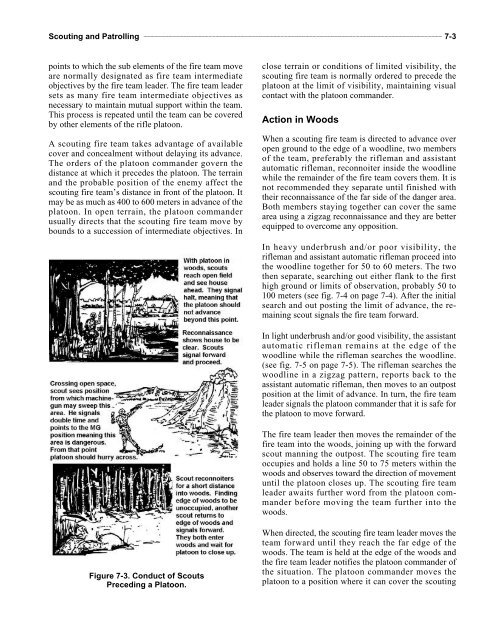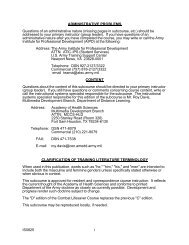MCWP-3-11.3-Scouting-and-Patrolling
MCWP-3-11.3-Scouting-and-Patrolling
MCWP-3-11.3-Scouting-and-Patrolling
You also want an ePaper? Increase the reach of your titles
YUMPU automatically turns print PDFs into web optimized ePapers that Google loves.
<strong>Scouting</strong> <strong>and</strong> <strong>Patrolling</strong> ___________________________________________________________________________________ 7-3points to which the sub elements of the fire team moveare normally designated as fire team intermediateobjectives by the fire team leader. The fire team leadersets as many fire team intermediate objectives asnecessary to maintain mutual support within the team.This process is repeated until the team can be coveredby other elements of the rifle platoon.A scouting fire team takes advantage of availablecover <strong>and</strong> concealment without delaying its advance.The orders of the platoon comm<strong>and</strong>er govern thedistance at which it precedes the platoon. The terrain<strong>and</strong> the probable position of the enemy affect thescouting fire team’s distance in front of the platoon. Itmay be as much as 400 to 600 meters in advance of theplatoon. In open terrain, the platoon comm<strong>and</strong>erusually directs that the scouting fire team move bybounds to a succession of intermediate objectives. Inclose terrain or conditions of limited visibility, thescouting fire team is normally ordered to precede theplatoon at the limit of visibility, maintaining visualcontact with the platoon comm<strong>and</strong>er.Action in WoodsWhen a scouting fire team is directed to advance overopen ground to the edge of a woodline, two membersof the team, preferably the rifleman <strong>and</strong> assistantautomatic rifleman, reconnoiter inside the woodlinewhile the remainder of the fire team covers them. It isnot recommended they separate until finished withtheir reconnaissance of the far side of the danger area.Both members staying together can cover the samearea using a zigzag reconnaissance <strong>and</strong> they are betterequipped to overcome any opposition.In heavy underbrush <strong>and</strong>/or poor visibility, therifleman <strong>and</strong> assistant automatic rifleman proceed intothe woodline together for 50 to 60 meters. The twothen separate, searching out either flank to the firsthigh ground or limits of observation, probably 50 to100 meters (see fig. 7-4 on page 7-4). After the initialsearch <strong>and</strong> out posting the limit of advance, the remainingscout signals the fire team forward.In light underbrush <strong>and</strong>/or good visibility, the assistantautomatic rifleman remains at the edge of thewoodline while the rifleman searches the woodline.(see fig. 7-5 on page 7-5). The rifleman searches thewoodline in a zigzag pattern, reports back to theassistant automatic rifleman, then moves to an outpostposition at the limit of advance. In turn, the fire teamleader signals the platoon comm<strong>and</strong>er that it is safe forthe platoon to move forward.The fire team leader then moves the remainder of thefire team into the woods, joining up with the forwardscout manning the outpost. The scouting fire teamoccupies <strong>and</strong> holds a line 50 to 75 meters within thewoods <strong>and</strong> observes toward the direction of movementuntil the platoon closes up. The scouting fire teamleader awaits further word from the platoon comm<strong>and</strong>erbefore moving the team further into thewoods.Figure 7-3. Conduct of ScoutsPreceding a Platoon.When directed, the scouting fire team leader moves theteam forward until they reach the far edge of thewoods. The team is held at the edge of the woods <strong>and</strong>the fire team leader notifies the platoon comm<strong>and</strong>er ofthe situation. The platoon comm<strong>and</strong>er moves theplatoon to a position where it can cover the scouting



